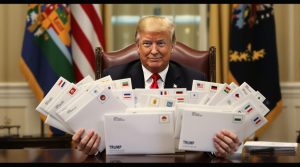
After working in capital markets since 1994, this week’s moves caught my attention for reasons that have nothing to do with trade percentages. Trump sent 25 tariff letters to world leaders with August 1 deadlines. Everyone’s parsing whether Canada’s 35% rate versus South Korea’s 25% means anything for negotiation strategy.
They’re looking at the wrong thing entirely.
What struck me isn’t the tariff rates — it’s the timing. Federal appeals court arguments on Trump’s emergency powers authority happen next week. Powell’s Fed meeting lands July 29-30. August 1 implementation deadline follows immediately after.
In my experience, when legal challenges, monetary policy decisions, and major deadline implementations stack up like this, it usually means someone’s testing how far institutional authority actually extends.
⸻
The Court Case Everyone’s Ignoring
The appeals court arguments challenge whether Trump can impose tariffs under emergency powers law. Most coverage treats this as procedural noise. But emergency powers precedent affects way more than trade policy — it establishes how much executive authority exists during any crisis.
Meanwhile, Powell already admitted publicly that tariffs prevent Fed rate cuts. Think about that for a second. The Fed chair just confirmed that trade policy constrains monetary policy. Fed independence becomes conditional when political pressure intensifies.
I started tracking central bank gold purchases more closely after Powell’s admission. Turns out central banks are buying about 900 tonnes this year, which suggests they’re preparing for something beyond normal portfolio rebalancing.
The pattern reminds me of 2018-2019 when institutional flows shifted ahead of policy clarifications rather than after them.
⸻
Powell’s No-Win Situation
The Fed meeting timing seems almost designed to create impossible choices. Powell can cut rates and validate Trump’s trade strategy, or hold steady and fuel criticism about institutional stubbornness. Either choice signals that monetary policy serves political objectives.
What really caught my eye was the Fed renovation cost ballooning to $2.5 billion from $1.9 billion while Powell faces removal pressure. The optics couldn’t be worse — spending billions on building upgrades while refusing rate cuts that could reduce government interest payments.
Fed funds futures show 76% probability of holding rates steady in July. The market basically expects paralysis, which tells you something about institutional confidence right now.
Foreign central banks seem to be reading the same signals. Gold purchases by European and Asian central banks accelerated this quarter, suggesting they’re positioning for reduced dependence on dollar policy decisions made under political pressure.
⸻
The Gold Signal I’m Watching
Gold’s been consolidating around $3,335 while J.P. Morgan targets $3,675 by Q4. That’s about 10% upside, but the institutional buying pattern matters more than the price target.
Central banks aren’t just diversifying for inflation protection. Physical gold purchases signal preparation for policy independence from dollar system constraints. When institutions move this decisively ahead of authority clarification events, it usually validates the positioning strategy for individual investors too.
Dollar weakness down 11% since Trump’s inauguration confirms that diversification trends are accelerating beyond normal rebalancing cycles. The combination suggests institutional recognition that dollar reserve status faces genuine challenges.
I’ve seen similar patterns during previous crisis cycles, and institutional behavior typically leads retail recognition by several months.
⸻
Positioning For What Comes Next
Based on what I’m seeing in the flows, August 1 represents more than a tariff deadline. It’s a convergence point for legal authority, monetary policy, and implementation reality.
My positioning focuses on assets that benefit regardless of how the authority questions get resolved: precious metals miners with North American operations, energy infrastructure companies that gain from supply chain reshoring, industrial materials with domestic production capabilities.
Gold exposure between $3,300-$3,350 makes sense before institutional rebalancing accelerates toward those J.P. Morgan targets. Copper, steel, and rare earth companies with domestic operations benefit from reshoring trends whether tariff policies survive legal challenges or not.
The setup rewards positioning before authority clarification rather than waiting for policy outcomes to confirm direction. Institutions are already moving. The question is whether individual investors recognize the pattern before it becomes obvious to everyone else.
Watch how the legal challenge, Fed meeting, and August 1 deadline interact. That convergence reveals more about institutional power structure than any trade war analysis.
Stay sharp. Stay sovereign.
— Reed
Reed Holloway writes for Wealth Creation Investing on the intersection of financial sovereignty, economic policy, and systemic risk. His work exposes government overreach, defends hard-asset strategies, and challenges the narratives that mask deeper economic instability.
